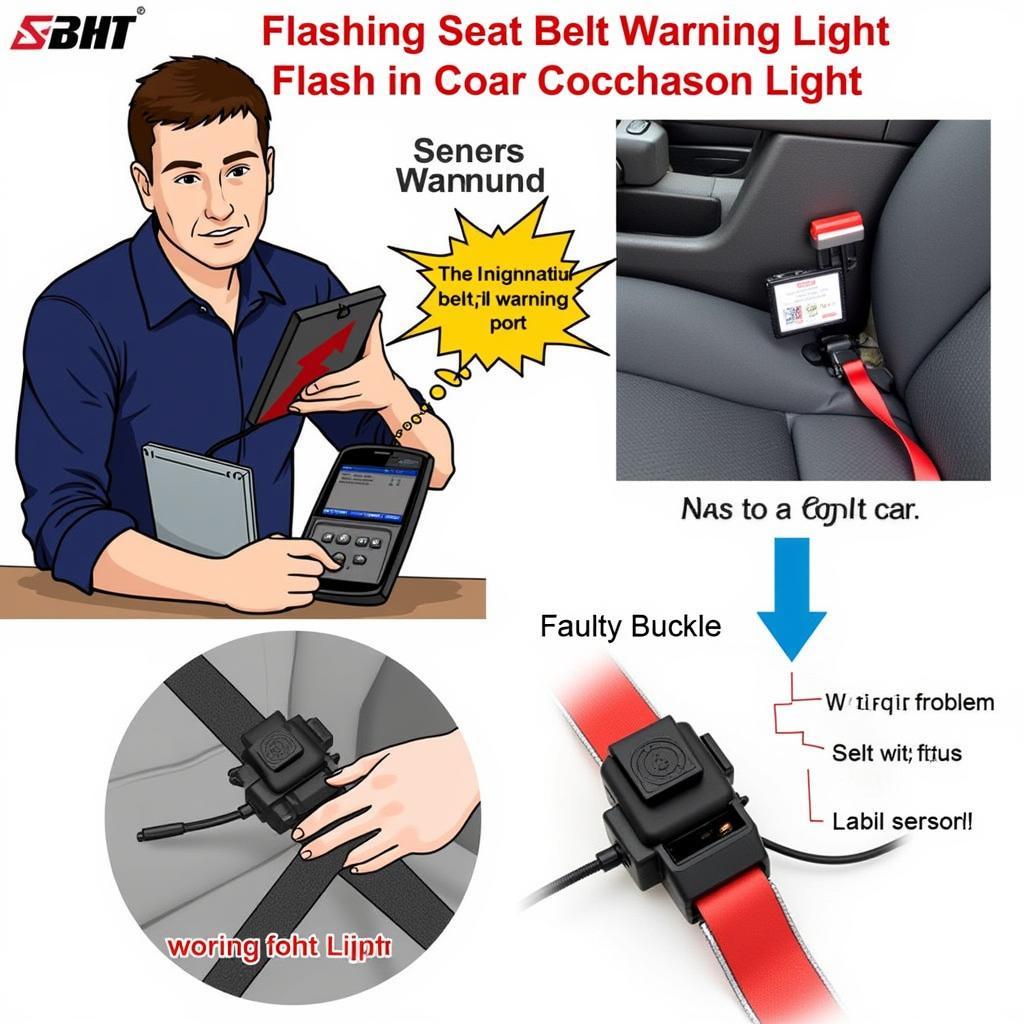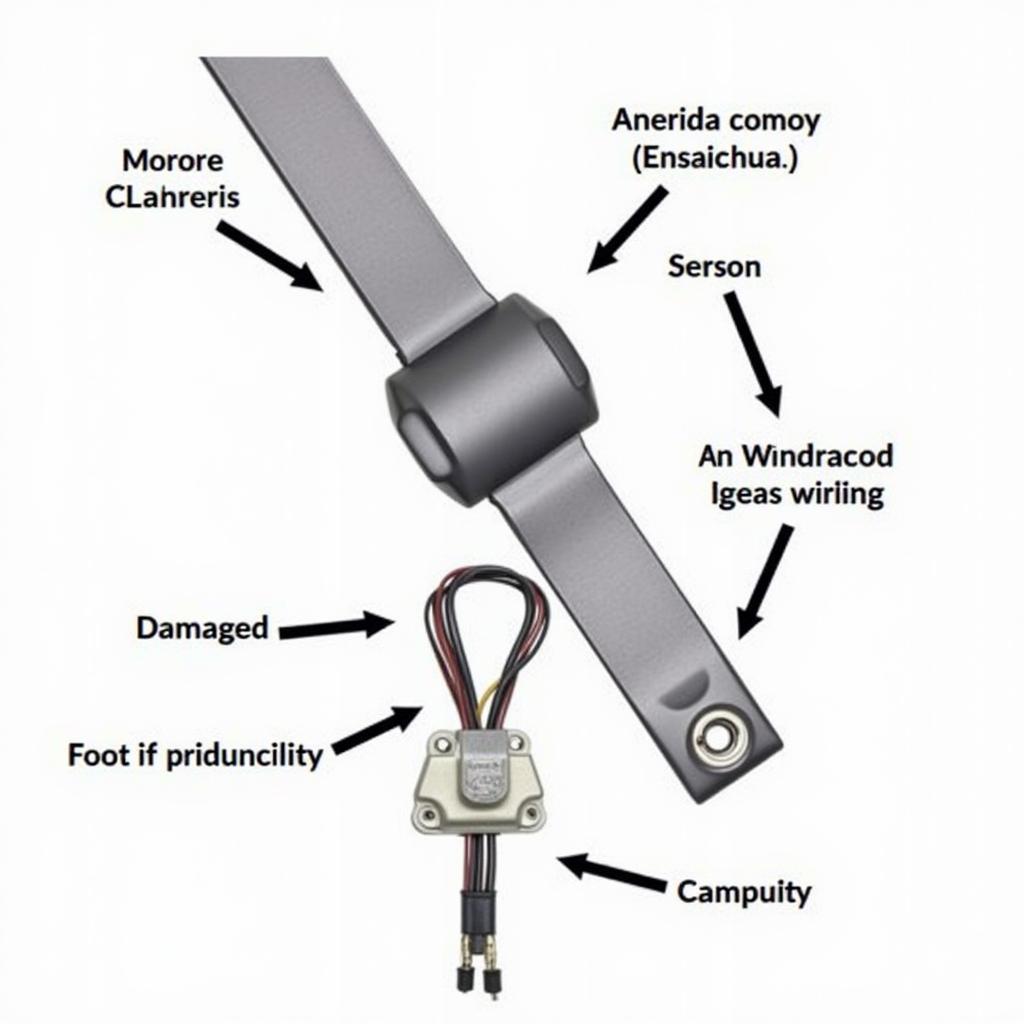A flashing seat belt warning lamp is more than just an annoying light; it’s a crucial safety indicator. Ignoring it can put you and your passengers at risk. This comprehensive guide delves into the causes of a flashing seat belt warning light, provides diagnostic steps, and explores potential solutions, including remote software installations and programming.
If you’re experiencing an Infiniti flashing seat belt warning lamp, you may be interested in this specialized guide.
The seat belt warning light is a vital part of your car’s Supplementary Restraint System (SRS), designed to remind occupants to buckle up. A steadily illuminated light is standard behavior. However, a flashing seat belt warning lamp signals a potential malfunction within the SRS, potentially impacting its ability to deploy airbags and other safety features during a collision. Understanding the underlying causes is crucial for maintaining your vehicle’s safety standards.
Understanding the Flashing Seat Belt Warning Lamp
The most common cause of a flashing seat belt warning lamp is a faulty seat belt buckle, wiring issue, or a malfunctioning sensor. In modern vehicles, the SRS is a complex network of interconnected components. Any disruption within this system can trigger the flashing warning light.
Diagnosing the Issue
Diagnosing a flashing seat belt warning lamp requires a systematic approach. Here’s a breakdown of the process:
- Visual Inspection: Check all seat belt buckles for damage, debris, or improper connection. Ensure the buckles latch securely.
- Wiring Check: Inspect the wiring harnesses leading to the seat belt buckles and sensors for signs of damage, corrosion, or loose connections.
- Diagnostic Scan: Using a professional-grade OBD-II scanner can pinpoint the specific fault codes stored in the vehicle’s computer, offering valuable insights into the problem area.
- Sensor Testing: Specialized diagnostic tools can be used to test the functionality of the seat belt sensors.
 Flashing Seatbelt Warning Lamp Diagnosis Process
Flashing Seatbelt Warning Lamp Diagnosis Process
Common Causes and Solutions
Several common culprits can trigger a flashing seat belt warning light. Understanding these causes can help you determine the appropriate course of action.
Faulty Seat Belt Buckle
A malfunctioning buckle can prevent the sensor from registering that the seat belt is fastened, resulting in a flashing light. Replacing the faulty buckle is usually the solution.
Wiring Issues
Damaged or corroded wiring can disrupt the communication between the buckle, sensor, and the SRS module. Repairing or replacing the affected wiring can resolve this issue.
Malfunctioning Sensor
A faulty sensor may incorrectly signal that the seat belt is unfastened, triggering the warning light. Replacing the defective sensor is typically necessary.
 Seatbelt Buckle, Sensor, and Wiring Components
Seatbelt Buckle, Sensor, and Wiring Components
“A simple loose connection can often trigger a flashing seat belt warning light,” says David Miller, Automotive Electrical Systems Engineer at AutoTech Solutions. “A thorough visual inspection of the wiring is crucial before replacing components.”
Software-Related Issues
Sometimes, a software glitch in the SRS module can cause the flashing warning lamp. In such cases, remote software installation or reprogramming might be the solution.
Remote Software Solutions
Modern vehicles rely heavily on software to control various systems, including the SRS. Remote diagnostics and software updates are becoming increasingly common in addressing these issues.
Remote Diagnostics
Remote diagnostic tools allow technicians to access a vehicle’s computer remotely, retrieve fault codes, and analyze the SRS data without physical access to the car. This can expedite the diagnostic process and identify software-related problems.
Remote Programming and Installation
If a software glitch is causing the flashing seat belt warning lamp, remote programming and software installation can often resolve the issue. This involves uploading updated software to the vehicle’s SRS module remotely, correcting any bugs or errors.
You can find resources regarding the flashing seat belt warning lamp qx4 and infiniti flashing seat belt warning lamp online.
“Remote software updates are revolutionizing the automotive repair industry,” explains Sarah Chen, Senior Software Engineer at Connected Car Solutions. “They provide efficient and convenient solutions for many software-related problems, including issues with the SRS.”
Conclusion
Addressing a flashing seat belt warning lamp promptly is essential for ensuring the proper functioning of your vehicle’s safety systems. Whether it’s a faulty buckle, wiring problem, or a software glitch, taking the necessary steps to diagnose and resolve the issue can help prevent potential hazards. If you are experiencing an issue with the passenger seat belt warning signal on passenger, or need to reset a warning light like the how to reset brake warning light on bmw 1 series, it’s best to consult a qualified technician. Remember, a properly functioning SRS is critical for the safety of you and your passengers.
FAQ
-
Why is my seat belt light flashing even when I’m buckled up? This could indicate a problem with the buckle, wiring, sensor, or the SRS module itself.
-
Can I drive with a flashing seat belt warning light? While you can technically drive, it’s not recommended. A flashing light indicates a potential problem with your SRS, which could compromise your safety in a collision.
-
How much does it cost to fix a flashing seat belt warning light? The cost varies depending on the cause. A simple wiring fix might be inexpensive, while replacing a sensor or module can be more costly.
-
Can I fix a flashing seat belt warning light myself? Simple checks like inspecting the buckle and wiring can be done at home. However, more complex diagnostics and repairs require specialized tools and expertise.
-
What is the SRS module? The SRS module is the central control unit for your vehicle’s Supplementary Restraint System. It monitors the sensors and deploys airbags and other safety features in a crash.
-
Is a flashing seat belt light always a serious problem? While a flashing light indicates a potential issue, it doesn’t always signify a major malfunction. However, it’s best to have it diagnosed and repaired to ensure your safety.
-
Can remote software updates fix all SRS problems? Remote updates can address software-related glitches. However, they won’t fix hardware problems like faulty buckles or sensors.

